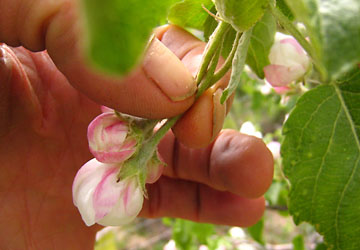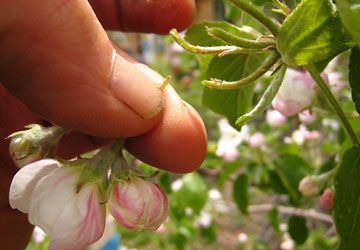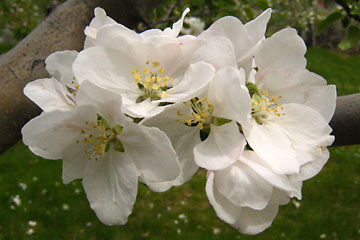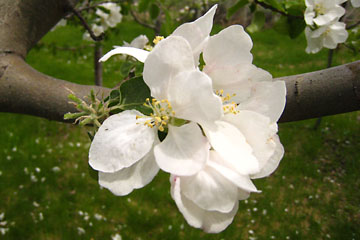home | internet service | web design | business directory | bulletin board | advertise | events calendar | contact | weather | cams

|
Less is More 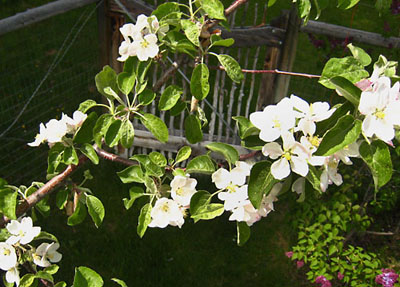 The branch to the right has five blossom clusters, some touching each other. The branch is only strong and long enough to carry two or three mature apples. It will be thinned to two or three clusters. The branch to the right has five blossom clusters, some touching each other. The branch is only strong and long enough to carry two or three mature apples. It will be thinned to two or three clusters.
There's not a prettier time to be tending to fruit trees than spring, so why not enjoy the fragrance and beauty of apple trees in bloom, eliminate some tedious labor you'd have to do later and benefit from healthier trees that hopefully will bear fruit every year? Blossom thinning is a technique that improves the quality of the apples, helps retain the vigor of the trees, and improves the likelihood of having an annual crop. For the small-scale home orchardist, it also saves labor. Wild apple trees (and many of the older varieties), when left to their own, will bloom and set fruit on alternate years. One year they're laden with branch breaking burdens of small apples, the next there is little, if any, fruit. This behavior has been selectively bred out of many of the modern varieties, but can still be an issue with older types. Many home orchardists have chosen older apple types in order to enjoy better, more complex flavors than are often available with the newer varieties. Some older apples have better storing properties. Some orchardists plant a variety of apple types to increase the length of the ripening season, ensuring a mature harvest from some trees regardless of the annual variations in fall weather. With blossom thinning, an alternate year blooming cycle can be interrupted, often times yielding reasonably consistent annual harvests. We thin off entire blossom clusters, leaving remaining blossom clusters spaced as we would mature apples. When an apple fruit spur sets one or all of its pollinated blossoms, it receives hormonal signals from the developing fruit. Even if all that fruit is thinned off later in June, the spur has already undergone a chemical transformation for that season, and therefore may not bloom the following year. By removing all of the blossoms in each cluster, that fruit spur is deprived of those hormonal signals for this year. Therefore it will more likely bloom the following year than if it was allowed to set even one fruit this year.
Often, on a heavy bloom year, two adjacent spurs will bloom. Without blossom thinning, all the fruits from those two spurs will be thinned in June to only one apple. By thinning off one of the blossom clusters, it will likely bloom the following year. The alternate year cycle is disrupted, hopefully yielding two good years instead of one burdensomely heavy and the other a bust.
Whether blossom thinning or thinning fruit, select what is to be thinned with the final quality of fruit in mind. Apples exposed to full sun yield better quality fruit than those that grow deep in the shade of the interior of the tree. Therefore, when thinning blossoms, retain clusters that are on branch tops and thin off those on the undersides, or those that will be shaded by or rub against fruit above. 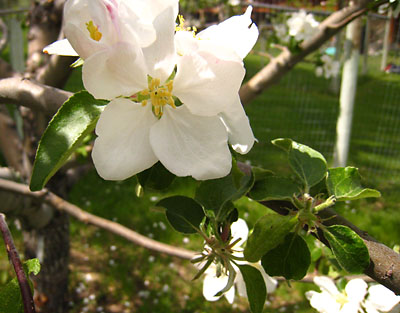 The lower, shaded blossoms have been thinned off. Apples exposed to more sun will yield better quality fruit. The lower, shaded blossoms have been thinned off. Apples exposed to more sun will yield better quality fruit.Finally, along with it being easier to see a cluster of white or pink flowers in May than a green marble or pea sized fruit in June, nipping off the blossom stems with a thumb nail is much easier and faster than fruit thinning later in June. It may seem counterintuitive that thinning your fruit trees twice instead of once will be labor saving, but we certainly find it takes less time and is much easier to visualize the final spacing of the maturing fruit. Comments Molly/Shane, thanks for this article, I was going to thin my green apples and make pectin and probably still will but taking off the blossoms is a great way to retain vigor, gonna use this article as my GRIST focus this morning on Da Root Don Ashford Winthrop I found this article very informative. I grew up on an orchard and didn't know this information. Makes me want to get out there and thin my apple blossoms! Thanks for the info. Wanda Wanda Myers Twisp
|
